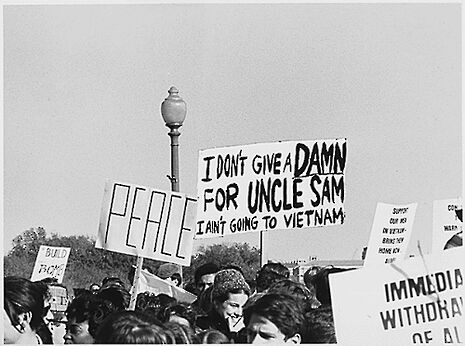Rebellious counterculture, and why it means nothing
Tracing the history of counterculture, India Stronach argues that there is something insidious lurking inside political rebellion

The term ‘contraculture’ was coined in 1960 by sociologist John Milton Yinger, defined as “wherever the normative system of a group contains … a theme of conflict with the values of the total society”. Where culture exists, counterculture is inevitable. The word gained traction with the rise of hippy philosophy in the 1960s, an anti-establishment philosophy and movement which was born in the UK and spread quickly across America and the West.
In the politically brittle atmosphere of the Cold War, students rallied for their right to free speech and freedom of assembly. In the UK, trust in authority was shaken by the scandal of the Profumo Affair, where Secretary of State for War John Profumo failed to hide his relationship with 19-year-old model Christine Keeler. In America, mistrust was stirred up by the Cuban Missile Crisis, and then the Kennedy assassination.
In this new era of mistrust, popular attention turned to human rights in a way it never had before, aided by a new ease of communication and publishing. Early hippy activists voiced demands for minority rights, created anti-poverty movements, raised environmental awareness, and with the sudden availability of birth control, ushered in the sexual revolution. In this politically tumultuous USA, the Stonewall riots marked the beginning of the modern queer rights movement, second-wave feminism sprung to life, and public opinion began to fall at odds with the desires of the government.
In the UK, this movement spun into a vast uprising against the rigid class system. Rock music became its herald, imported from America and bounced back in the British Invasion of 1964, spearheaded by (of course) the Beatles. Here, the various currents of counterculture – equal rights pioneers, hippies, and activists alike – were united through the shared hatred of establishment, optimistic politics, and love of rock’n’roll. They called themselves the London Underground, forming and circulating everything from fashion shows to illicit newspapers.
“Once enmity was truly stirred up between culture and counterculture, it was the establishment that began to fall”
The countercultures of the 1960s and early 1970s rejected the standard Western lifestyle of conformity and consumerism, but rarely objected to others embracing it. Initial conflicts were drummed up by the middle classes, who felt threatened by their children and the children of the poor uniting against the values they had held dear for generations. Once enmity was truly stirred up between culture and counterculture, it was the establishment that began to fall. Strikes led by students at the Sorbonne in 1968 almost crippled the French government. Dutch hippy movement Provo spent the ’60s proving the establishment could not be trusted by manipulating the police into initiating violence against innocent citizens.
Naturally, authority struck back. Mexican authorities clamped a blanket ban over all rock’n’roll performances for the entirety of the ’70s, fearing the American influence on Mexican youth. In America, the War on Drugs was started and turned against whoever the government wished to discredit – namely hippies, anti-establishment speakers, and people of colour. This has since been openly admitted by Nixon’s advisers: “We knew we couldn’t make it illegal to be either against the war or black, but by getting the public to associate the hippies with marijuana and blacks with heroin, and then criminalising both heavily, we could disrupt those communities.”
Although these strategies were successful, the countercultures of the ’60s achieved incredible changes, but possibly the most powerful of them was that rebellion became the new cool. Punk and post-punk picked up the anti-establishment train with renewed vigour and viciousness, sentiments echoed through the new waves of hip-hop, avant-garde art, graffiti, and even britpop.
“The patterns of the first wave of ’60s counterculture are stirring again”
By the modern day, no self-respecting teenager, twenty-something, or indeed fifty-something who remembers punk, would ever want to side with the authority. Youth votes flock to optimistic far-left candidates, minority rights factions break out in new waves of young activism. The patterns of the first wave of ’60s counterculture are stirring again, this time with the backup of the internet, instant communication, and the terrifying independence of social media.
But there is a dark side to counterculture. Where once the dividing lines might have been clear, the absolute certainty that only rebellion is cool means that any side of politics has to paint itself as heroes crusading against an oppressive majority. You’re not one of a million men defending the patriarchy, you’re a meninist bravely battling the anti-free-speech agenda of feminazis. You’re not homophobic, you’re an anti-SJW decrying the made-up genders and sexualities of an internet legion of special snowflakes. You’re not yet another in a generations-long line of white people silencing everyone else, you’re proudly reclaiming your country from the invasions of… someone. You haven’t had it all handed to you on a plate, you’re just that much better at life.
It’s entirely possible that cool is something we should stop using as a basis for our politics
 Comment / Plastic pubs: the problem with Cambridge alehouses 5 January 2026
Comment / Plastic pubs: the problem with Cambridge alehouses 5 January 2026 News / Cambridge academics stand out in King’s 2026 Honours List2 January 2026
News / Cambridge academics stand out in King’s 2026 Honours List2 January 2026 News / Cambridge businesses concerned infrastructure delays will hurt growth5 January 2026
News / Cambridge businesses concerned infrastructure delays will hurt growth5 January 2026 News / AstraZeneca sues for £32 million over faulty construction at Cambridge Campus31 December 2025
News / AstraZeneca sues for £32 million over faulty construction at Cambridge Campus31 December 2025 Interviews / You don’t need to peak at Cambridge, says Robin Harding31 December 2025
Interviews / You don’t need to peak at Cambridge, says Robin Harding31 December 2025









